Do toddlers stop drinking milk? How much milk does a 1 year old need? Or, a 2 year old? Get the answer, plus the best sippy cup for milk!
In the first year of a baby’s life, milk is a big deal! As parents, we learn very quickly from everything we read and are told that milk, in the form of formula or breast milk, is the only source of nutrition for a child for at least half of their first year of life.
Even after 6 months of age, we are told that “food is just for fun.” Milk is still the main attraction. But once babies turn one and become a toddler, is milk still just as important?
How much milk should a toddler drink?
Or, How much milk for a 1 year old, specifically? Does it matter?
It does! Milk is still important for toddlers, but it definitely plays a much different role for a one and two year old.
And, while this might surprise you, as a licensed pediatric occupational therapist (OT), I’ve seen milk (dare I say) cause or make picky eating worse, especially in toddlers and even 3 and 4 year olds!
I know it’s shocking because milk is the ultimate drink/food, but the truth is, it’s all in how much milk a toddler drinks and when.
So stick with me and I’ll lay all the toddler milk guidelines out for you,, also including my picks for the best sippy cup for milk, the best milk for toddlers, and what to do when a one or two year old won’t eat and only drinks milk.
How Much Milk Should A Toddler Drink… For a 1 Year Old?
First, let’s talk about what a toddler actually is, as there is generally some confusion. Your baby technically becomes a toddler on their first birthday and that whole second year, they are toddlers until they reach two.
Some folks, myself included, will consider 2 year olds toddlers as well. The end point of toddler-dom is less as important as knowing that it begins at 12 months old.
The reason it doesn’t matter is because the milk recommendation for toddlers is the same for all children through age 9!
So, how much milk should a toddler drink…?
Or, how much milk for a 1 year old?
Whether you’re wondering how much milk a 13 month, 14 month, or 15 month old should drink, the same clear and definitive answer is 2 cups or 16 oz of milk in one day.
That’s in accordance with the American Academy of Pediatrics (AAP).
Remember, that starts at 12 months or 1 year old. Of course, there is some transition time. After all, most babies at 10-11 months old are drinking between 24-30 oz of milk a day. The switch shouldn’t happen overnight.
But, once your child does reach their first birthday, it’s important to start being aware of how much milk they’re drinking and begin to focus more on their food.
You may have wondered, “when do toddlers stop drinking milk?” The answer is, they don’t stop. Milk is still VERY important for their development, it’s just no longer the star of the show.
This can be hard to get used to as parents, because the emphasis on milk was huge up until this point.
Check out this study if you’d like to read more about why 2 cups of milk a day is the magic number that’s suggested.
It’s also okay for your toddler to drink up to 18-20 oz in a day, as long as they are eating well. Some toddlers can handle, and may even need, those extra couple of ounces.
The problem with going over 16 oz, after you’ve been through the weaning process, is that they may fill up on too many of their calories with milk and they won’t look to food to fill them up, which they now need to be doing.
It’s important for toddlers to learn to eat during the ages of one and two because it’s the foundation for their future eating skills, even if they seem to be picky eaters at this point, which is totally normal.
However, if your 1 or 2 year old won’t eat and only drinks milk, you may need to proceed a little differently- more on that in a bit!
On the other side of the coin, sometimes toddlers have a hard time drinking that full 2 cups in a day, especially when they are transitioning from bottles or breastfeeding.
If your toddler won’t drink milk, it could be because they prefer nursing or the bottle that they have previously been used to.
The experience of drinking from a cup can be very different for some kiddos, and it can take some time. In this case, cheese and yogurt also count as part of their two cups of milk in a given day.
Some children never take to drinking much milk, and most of the time that is just fine if your child is growing and developing well. But, your doctor may want to put your toddler on a vitamin D supplement or even a calcium supplement.
Head over to Does Your Kid Need a Vitamin? if you’re concerned about your toddler’s milk intake.
And, if you need some help with transitioning off of bottles, then check out bottle weaning.
If you continue to breastfeed, or want to stop, there are a couple of factors you’ll want to keep in mind to get your toddler eating off to a great start. Check them out in weaning from breastfeeding.
Most of the time, I hear from parents that breakfast is the hardest because toddlers are used to having their bottle when they wake up. That’s true, we all love our routines and toddlers are no different.
Remember that changing your toddler’s milk schedule that they are used to will take time, but it is possible.
Head to toddler breakfast ideas if you need some inspiration for easy and healthy breakfasts to help with your new routine.
When Should A Toddler Drink Milk?
This is really just as important of a question as “How much milk should a toddler drink?” The guidelines go hand in hand because even if you’re only giving your toddler 16 oz of milk in a day, but you’re not giving it at the best time, it could still totally sabotage their eating, big time.
That ideal time for toddlers to drink milk is with their meals.
That is a big change right? Before, bottles or nursing sessions were separate events away from a meal, but now it’s important to serve milk as part of the meal.
This too, is a transition and does take some time. You can find a sample feeding schedule for toddlers that I think will be really helpful, if this suggestion seems overwhelming, and I know it can be.
Drinking milk during a meal is so important because if they are drinking milk in between, they never really have a chance to get hungry, and if they don’t have a chance to get hungry, they aren’t going to eat well.
This can lead to picky eater toddlers very quickly. This is why it is even more important to know when to give your toddler milk if they are a picky eater.
Get other tips to prevent toddlers from becoming picky eating here.
Keeping milk and food together in one meal creates a healthy appetite cycle. Ideally, you’ll be looking to feed your toddler every 2.5 – 3 hours, whether that’s a snack or a main meal.
The serving of milk can be equally divided among all those meals so they drink 3-4 ounces at every meal/snack or over three main meals with 5-6 ounces.
Head to Toddler Portion Sizes to read more about how much food a toddler should eat, and if you need inspiration for food, I’ve got you covered with over 40 ideas in Easy Toddler Meals and in Toddler Lunch Ideas.
Affiliate links used below. See our full disclosure.
The Best Sippy Cup for Milk
At this point, your next question probably is, “What type of cup should a toddler drink milk from?”
My answer is definitely a straw sippy cup.
You can read all about why I LOVE straws and how to teach your toddler to drink from a straw, but I will say that straw drinking is wonderful for speech and feeding development because it requires more coordination and is a more sophisticated skill.
The process of drinking through a straw is an important oral motor skill for eating.
Drinking from a regular sippy cup is very similar to drinking from a bottle. For this reason, a regular sippy cup could be a good transition from a bottle, but I’d focus on using it temporarily as a way to get to the sippy cup with a straw.
All three of my kids used or are still using a sippy cup with a straw, and we’ve tried a lot of them over the years.
One of my favorites for milk is the Avent straw cup because the straw is really easy to thread through the opening – trust me, this is a big deal when you’re unloading the dishwasher.
But, I also like to have an insulated version, too, to keep milk cold. Again, because of the ease of assembly, I like this Playtex straw-sippy cup.
For really young toddlers though, I love this smaller munchkin version. My youngest son loved these and so did I because it was smaller (easier for him to hold), had handles, a weighted straw (so he could get every sip), and a long flexible straw that was easy to suck out of.
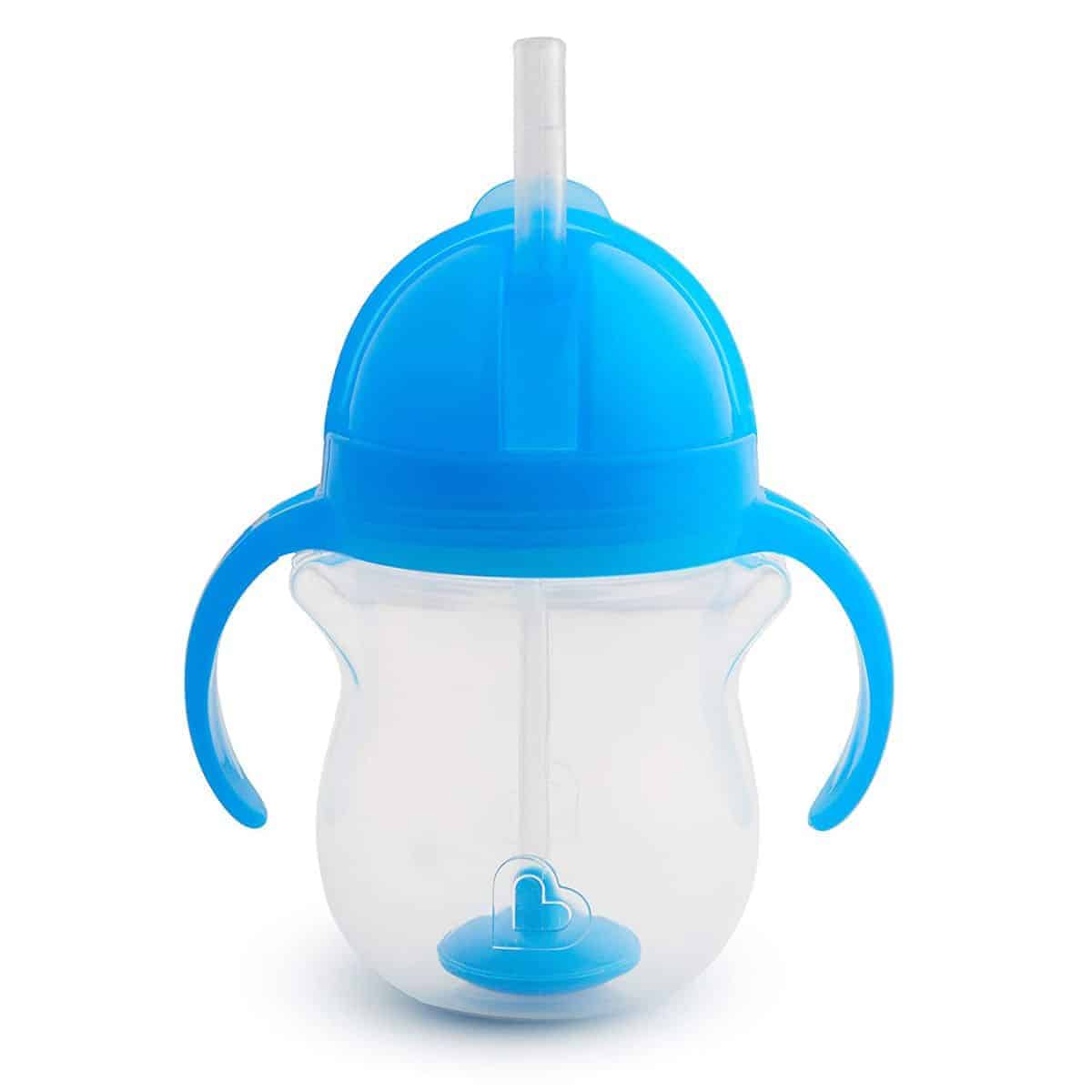
Perfect for beginning or young straw drinkers!
Don’t feel like you need to overcomplicate things. A simple straw cup that you can give your child will do.
To sum up my top picks for the best sippy cup for milk:
- Munchkin Flexi-Straw Cup – Perfect for young toddlers
- Playtex Sipsters Stage 3 – Insulated and great for older toddlers
- Avent – Includes measuring lines to keep track of how much milk you’ve given, easy to use
- Mini Silicone straw cups– simple, easy to clean and easy to hold in little hands.
There are a ton of options out there, so whatever you choose, you do want to make sure the straw is thin, as thicker ones can mimic traditional sippy cups and defeat the benefit of using a straw.
Bonus Mom Tip: I give one milk cup a day to my toddler and keep it in the fridge between meals, that cuts down on wasting any milk he didn’t finish while eating.
The Best Milk for Toddlers
So that leads us to the last question that you likely have, “What is the best type of milk for a toddler?”
The quickest and shortest answer is: whole fat cow’s milk.
But, this question isn’t as cut and dry as the others. For instance, it’s totally great to still give your baby breast milk or nurse them.
And, if your toddler is allergic to milk or dairy, your doctor will likely want your 1 year old on a special toddler formula. However, infant formula shouldn’t continue to be given.
Also, in some instances with children that need extra calories, for a variety of reasons, doctors will prescribe a special toddler formula for that purpose.
By and large, most toddlers will drink cow’s milk, and unless your doctor tells you otherwise, it should be whole milk.
Sometimes, it’s recommended at age 2 to drop down to 2%. Personally, I prefer to keep kids on whole milk, as long as too much weight isn’t an issue.
However, it’s becoming increasingly common for children to develop severe constipation or other digestion problems from dairy. You’ll want to keep an eye out for that.
This was definitely the case with my oldest son. We saw immediate relief at age 2 when reducing his milk to 2%. Ultimately, we ended up switching him to almond milk, with my second son following the same pattern.
You can find more solutions for constipation here, if that is a challenge for you too! Please note though that almond milk and other milk alternatives generally aren’t recommended for young toddlers because they have much lower calories and fat.
You’ll definitely want to discuss any concerns with your milk selection with their doctor.
Lastly, whether you decide to go organic or not is a personal choice. I will tell you that we do. If this is something you’re on the fence about, I’ve got you covered in Does Buying Organic Matter?
This guide will help you feel good about your choice to buy organic milk or not.
Help: “My 2 Year Won’t Eat and Only Drinks Milk”
You are not alone! Some picky eater toddlers rely on milk as their major, and sometimes only, source of nutrition.
Suddenly cutting down how much they’re drinking to only 2 cups might not change anything about their eating because it’s likely that there’s something contributing to their picky eating that needs to be addressed or worked through.
Read about 5 different reasons kids don’t eat.
Before you decrease how much milk they have, it’s really important as step number one to get a solid mealtime routine in place.
I have 9 tips to improve eating that are essential to making any progress with kids not wanting to eat. You find those out in Good Eating Habits for Kids.
Once you have that solid routine in place, you can start to give milk with meals only and slowly reduce how much milk they’re drinking.
Take baby steps if you need to, taking away milk for just an hour at first, assuming they always have access to it.
Or, maybe put a couple less ounces in their cup and sit them at the table with at least one food they’re most likely to eat and their milk instead of walking around and drinking.
If possible, you’ll also want to avoid distractions, like using a TV or tablet, to help your child eat. I know it gives a quick win, but in the long run, it’s going to hurt their eating.
Find out more about why screen time and eating are a bad idea.
Most of the time, slowly weaning away from those distractions is a great place to start if you’re relying on them during meals.
Lastly, don’t hesitate to look into feeding therapy if you think you need some help. It never hurts to at least go and see! And, if you live in the U.S., you might qualify for free early intervention (that means therapists actually come to your house).
To take steps making changes in your home right away though, save a seat in my totally free workshop: 3 Keys to Turn Around Picky Eating!
These are my BEST strategies and they can have a huge impact on your child eating more foods and drinking less milk.
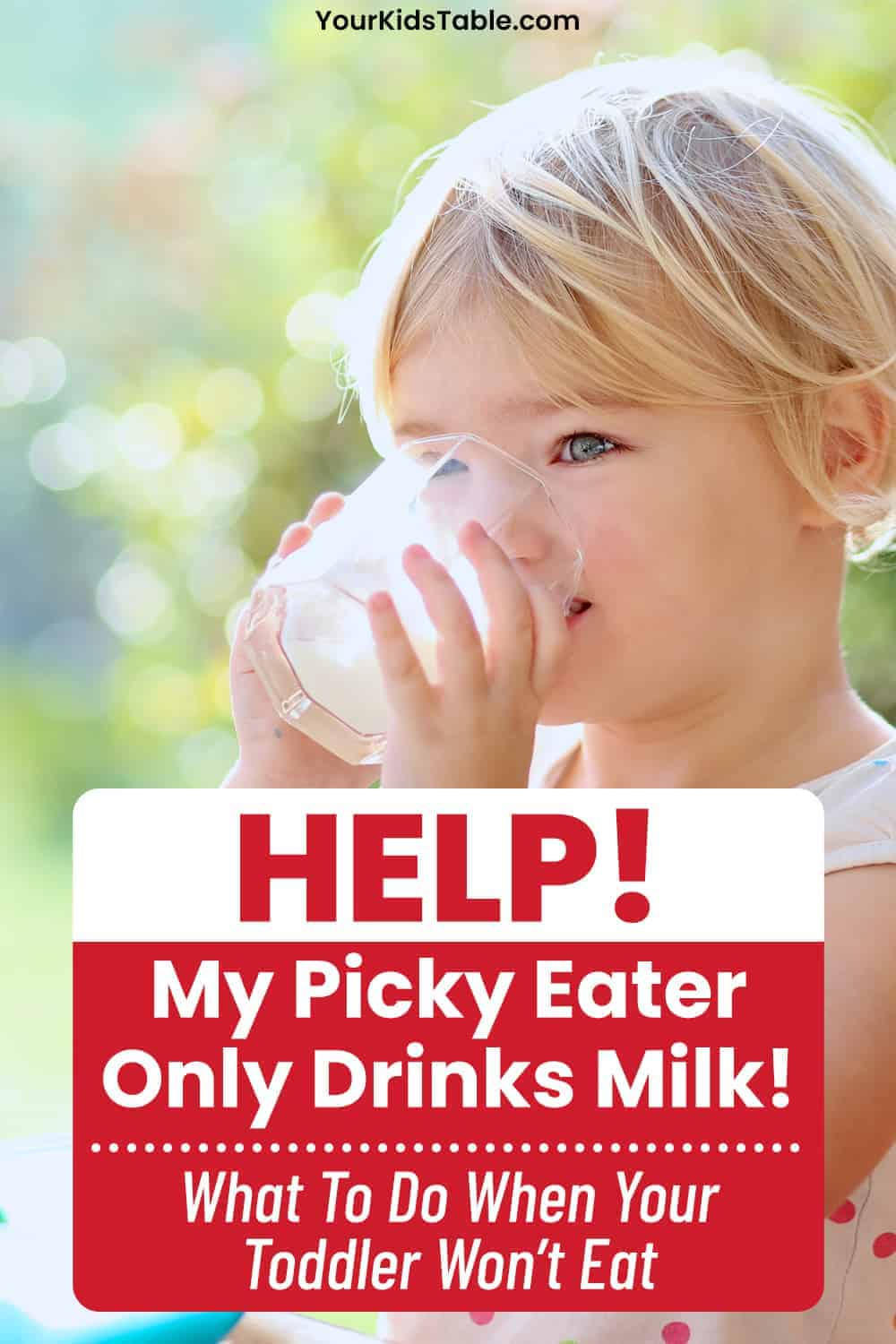
Did You Pin This?
More on Feeding Toddlers from Your Kid’s Table
Self-Feeding: The Complete Guide for Babies and Toddlers
The Ultimate List of Baby/Toddler Meal Ideas
How to Transition Your Baby (or Toddler) to Table Foods Easily and Safely
The Mega Guide to Feeding Milestones for Babies and Toddlers
Alisha Grogan is a licensed occupational therapist and founder of Your Kid’s Table. She has over 20 years experience with expertise in sensory processing and feeding development in babies, toddlers, and children. Alisha also has 3 boys of her own at home. Learn more about her here.
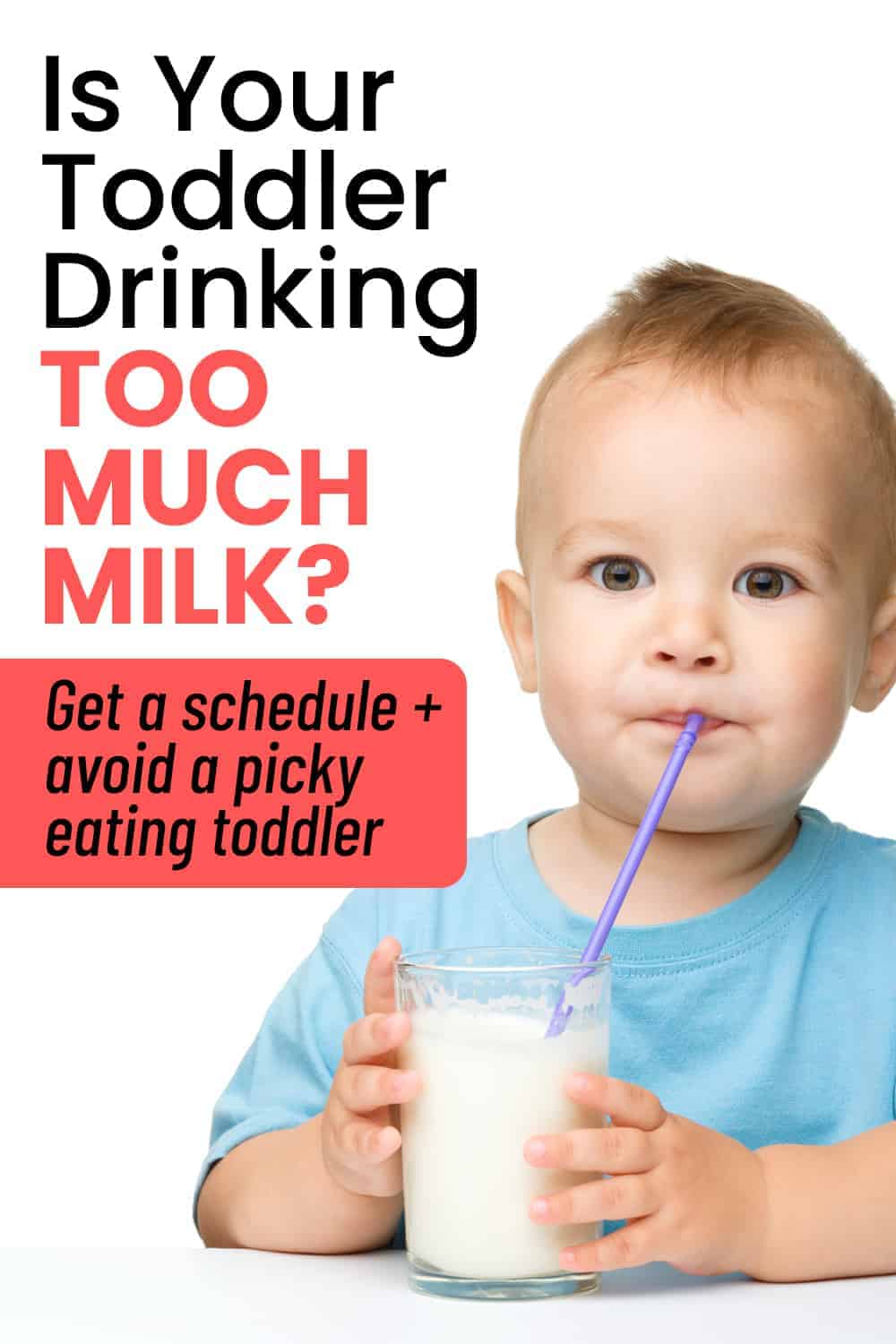
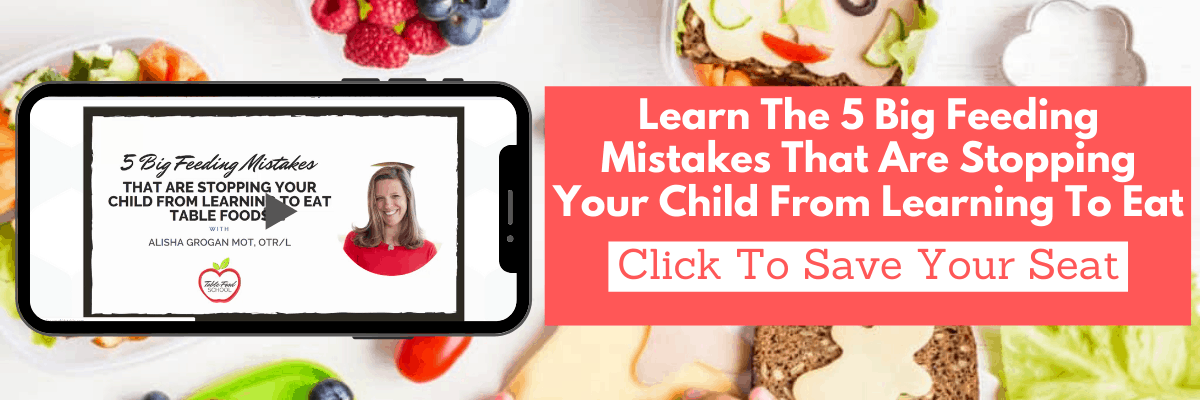
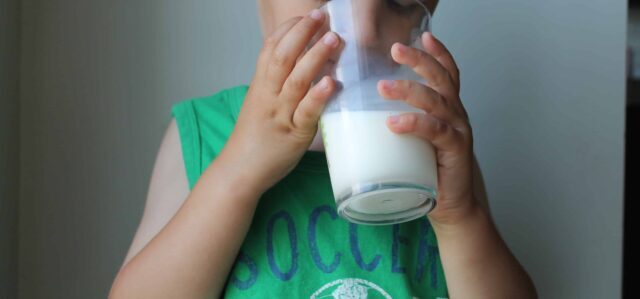
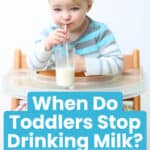
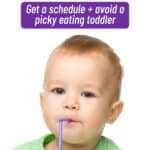
After waking up over and over in the middle of the night to a whining two year old who is hungry for milk, your article is just what I needed to read! In the back of my mind, I have known milk has been causing picky eating and midnight fussing. Now I have some great advice and tools to help get my baby on the right track. Thank you!!
Aww Andrea,
I have been here and get it! So glad you found some hope because there definitely is hope for improvement! Please stick around and let us know how things go!
Best,
Laura
Your Kid’s Table Occupational Therapist
I have read your article and I’m just starting with lunchtime…my issue is that my son doesn’t drink much with his meal so I’m not sure how I’m going to get him to drink enough? He has never been into drinking milk all that much anyway, but definitely not with meals. I’ve always had to be a bottle before meal because he prefers food.
Hi Stacy! That’s great that he prefers food over milk! I wouldn’t worry too much about that. If he’s drinking some milk, or milk in his cereal, plus cheese or yogurt, then he’s most likely getting enough. For beverages, just try offering mostly water and making sure he stays hydrated!
Best,
Kalyn
My 19 month old refuses to eat anything except fries and strawberries but now doesn’t really want that. All he wanted to eat before was chicken nuggets but now won’t eat that. I’ve tried giving him other stuff but he fusses every time and won’t eat anything. All he wants is milk and I don’t know what to do anymore. My pediatrician is no help and just says “he needs to eat” every time. Any advice?
Hey Danielle,
We understand the struggles and how hard it can be! I’d start with trying to do some food play outside of mealtimes, to get him touching/engaging in the foods, as touching is the first step to eating. Also, removing pressure from mealtimes can make a huge difference. We have a free workshop that is a great place to start that walks you through how to remove pressure and first steps to work on picky eating. You can save your seat here
Best,
Desiree
Hi,
My kid is already 2.5 years and he still wants to drink milk with bottle. Although I have started the process of avoiding bottle completely during the day time but he cries and ask for the bottle for 15 mins and then somehow I make him drink with the glass by telling some stories. He still asks for bottle during midnight, so I am continuing bottle in only midnight. My concern is he is not drinking 2 cups (500 ml approx at his age ) in a day because of glass/sippy cups. He used to consume more milk with the bottle. Should I be worried about the consumption or is it okay to drink 180 ml or little less 3 times a day(morning, noon/evening and night?
Hey Rashmi,
I’d be looking at other sources of dairy that he may be eating to get to the recommended amounts such as cheese or yogurt. These can help get to your recommended dairy intake!
Best,
Desiree
My 14 month toddler completely rejecrs milk. Since birth he was breastfed (6 months EBF) and continued till his 1st birthday. He self weaned after that but possibly as i entered my 2nd trimester (of 2nd pregnancy) it might have dropped. Since then he has fruit juices and home cooked meals but i am unable to start him drinking milk whether in bottle/sippy cup/360°cup/ glass.
Please guide me how to start
P. S he does take milk products like cheese sweets or porridge etc
Sounds like you are doing some really great things to help him along. I would pick a novel cup (we recommend a straw cup) but one that has his favorite characters or animals on it, and continue to have it around for him to be drinking. The transition from breastfeeding to milk can take awhile, but be consistent.
Best,
Desiree
I am going through the same thing 19 months refuses to drink milk. Breast fed him till now. Now he is 20months it’s been a month that I had to wean him because I am expecting another baby.
HI Sakina,
Weaning babies and toddlers can be really tough! If your little one doesn’t have too much experience drinking from a bottle or cup, it might be a little intimidating for everyone! You might try offering an open cup or one with a straw during mealtimes during the day. Often times the feedings during the day are the easiest to drop (you would drop morning and night feedings last). Our posts on Straw Drinking and How to Wean might be helpful to your little one!
Best,
Andrea
My 16 month old drinks 16ish oz. total of milk out of a sippy when he wakes up, before his nap and before bed. (Sometimes he will refuse it.) He doesn’t have many issues not eating at meals. He has been drinking out of a straw cup since 6 months. When I give him milk at meals instead of water, he takes one sip and doesn’t drink anymore, but with water he will continue to drink throughout the meal. How would you handle this? He also doesn’t like silicone straws.
Hi Jacquelyn,
It sounds like your little one is getting a good amount of milk and food, so that’s wonderful! If you’re wanting to move him away from drinking milk separately from mealtimes, that process often goes really slowly. You can kind of think of it as another step to weaning! Toddlers usually don’t love giving up the milk right before sleeping, so offering the milk he drinks right when he wakes up with his breakfast might be a good first step. You can also check out our post on straw drinking for some more suggestions.
Best,
Andrea
I’m crying I’m so happy…this is the information I was looking for!! Thank you for such amazing advice.
So happy we can help 🙂
Hi, Ms. Alisha!!! I have problem to my one year old son he wants more milk than the solid foods. I gave him whole milk and some prunes. Because his poop is so hard everyday. So i’m planning to less his milk and more solid foods so that his poop will make regular everyday?
Hey Lou,
I’d try to decrease it over time so that it is an easier transition. You can use tips in the article for when to offer foods and milk! Hope this helps!
Best,
Desiree
Hello there my 2 year old baby boy is not eat much he is jus relay on milk ..after forcing he eats too littte like oats in milk nothing else plz teme what to do he is taking milk in god level..plz healp
Hey Meenu,
Thanks for reaching out! We understand this can be difficult as the kids do like to drink their milk, however it does make them feel full. I’d try to space out when you are providing Milk and only provide during meals with his food. You’d find some great suggestions in our free picky eating workshop on how to set this up! Save your seat HERE
Best,
Desiree
Nice post!
Hi,
My twins are about to turn one. With the change to whole milk and having milk with meals do you have a recommendation for early morning wake ups? They need to be at daycare early in the morning (7am). Do you think we should give a sippy cup of milk when they first get up and then have them eat breakfast once at daycare? Or do you have any suggestions?
That could work! At least for now, as they get older, you can phase that sippy cup out. Experiment and see what works for all of you!
Hi my daughter has just turned two. She is a great eater but I am finding it hard to get her to drink the cows milk. Do you have any tips how to introduce it? Thank you
*Sorry turned one.
Thanks for reaching out! So whatever milk she is drinking at this time, you can mix 75% of that milk (even breast milk) and then 25% of cow’s milk. Then after a few days if that transition went well, you’d change it to 50/50. And continue from there every couple of days or a week. Make sure it goes slow enough that they are adjusting well, some kids take more time than others.
Best,
Desiree
I was just wondering about bedtime milk. Mine drink about 16oz each at bedtime. They’re 23 month old twins…:
They’ve also been drinking around 8oz after lunch before nap time which I’ll reduce and combine with lunch in a cup as you’ve recommended.
If they’re eating and growing well, you probably don’t need to worry, but I’d check with your doctor. However, many kids don’t need that milk before bedtime at that age.
Hi Alisha, My baby is soon turning one and I am starting the weaning process now. How much cow milk should I introduce per skipped breastfeed. Also, do yoghurt and other milk products also count in your 16 oz recommendation for a one year old?
They can, for sure, but don’t have to. Check with your doc for their specific recommendations. You could start my offering just 2-3 ounces at a time as she’s transitioning, remember you’ll want to mix it with her current milk.
Hi there, thank you so much for your post as i was just wondering about the amounts i give. I give exactly the same amount you recommended and with meals. I always felt it was right to be served with meals…and also bc when you’re starting food you’re supposed to give milk right after the food, so that makes sense.
I want to respectfully comment that we transitioned to almond and flax milk in order to stay away from dairy and the affects on the digestive system. It has a greater amount of calcium and he gets his calories and fat from food (although I’m sure it’s a diff concern for more picky toddlers).
Thanks again!
I love that, yes dairy is problematic for so many kiddos – including 2 of my own!
Thank you very much for this post. I was really shocked since my baby has been drinking milk at 50-60 Oz per day. I need to cut down her milk intake this time .
Thank you so much for this post! I have been struggling to figure out how to transition from formula to milk now that my daughter has turned 1, especially when to give it to her and how much. It is not just a simple switch. She used to drink her formula from a straw cup before every meal, and since we started giving her milk she will only drink it with her meal. She won’t drink much of it, but I guess that’s something to keep working on. It’s weird to shift from milk being the main food source to being part of the meal, but that’s what my daughter seems to want to do. This post helped me understand better what my daughter seems to be innately doing on her own. Thank you!
It is weird, it’s a hard transition for us parents too! I’m so glad this gives you valuable insights! Sounds like you are on the right track!
I’m starting to wean my 23 month old who is a boob monster. Do I have to give him a sippy cup of milk in the morning and at night or can I go straight to just giving him breakfast and just milk with his dinner or does he need milk before bed at night also.
Thanks
Gillian
I think it’s a personal call, but ultimately that’s where you want to end up. I’d check with your doctor, but you should be good to go. This feeding schedule example might be helpful!
First off I want to thank you so much for the information you give in this blog it’s been a God send ever since my son refused to do baby food of any kind.
At my sons 12 month well baby visit, our doctor told us to limit his milk consumption to 2 cups per day due to the insane constipation the transition gave him. Due to reading this post previous to the appointment I thought it would be a lot more gradual of a transition. At any rate we’ve been trying to implement the 2.5-3 hours between meals and water in between recommendation you’ve given. I’m just curious if we’re doing it wrong because some meals he doesn’t really eat but he drinks an insane amount of water in between like 10+ ounces of water between meals. Is that normal? Will his water drinking slow down or is this the new normal? Will it take a while for him to start eating more at meals?
Thanks again for the wonderful insights.
Oh you’re so welcome! I’m so glad it’s been helpful! I’d mention the water drinking to his doctor, but as far as I know, it shouldn’t be affecting anything. It is normal for toddlers to eat sporadically though, if he has some meals that he is eating well and is growing well according to your doctor, I’d keep up with the routine and structure around meals.
So glad you found your way here!
Hi! I have an almost 20mo, she loves her milk, but also loves her food. She’s developed some nighttime sleep issues & seems to always be phlegmy. She’s definitely over the recommended 16oz most days, do you think I should start limiting even though she still eats meals & snacks well?
I’d check with her doctor, is she growing well? If not, they may not want to decrease.
yes! her doctor didnt see an issue with it and shes growing like a champ! i’m worried about the amount of sugar shes consuming. we’ve started limiting milk at bedtime in hope that helps!
I’ve gained a lot from your articles as my son nears the big birthday! However I’m having trouble finding recommendations for how much water he should be getting per day. I used to give it with meals as his formula was separate from those times but now I’m not sure where to fit it in, or how much he should aim for. Thanks for any help!
Start by having water always available in a no spill cup. Put it out where he’s playing. Offer it to him. I’d check with your doctor, but a good rule of thumb is half their weight in ounces. So if they’re 20lbs, 10 oz of water.
Hello, I’m so glad I just found this blog. I just got my 26 month old off his bottle at the beginning of February. It had been a real struggle because he was attached it was his only comfort besides me. Since then he will not drink milk anymore because it’s in a cup I’ve bought ever cup available he will throw it and ask for a bottle. He will drink water or a little juice out of his cups. Should I give up the milk or give him the bottle back? Thank you
Hi Jana, that’s a tough call. If it were me I’d keep offering a little everyday, but I’d check with your doctor:)
will your child drink water out of a cup? we started with a straw cup for water before 1, then after she turned 1 i slowly transitioned by dropping a bottle to milk in a cup at meal time. my plan was drop a bottle each month & be done by 15m. lunch was the first (& the easiest), then dinner, then breakfast, then nighttime. i dreaded the nighttime, but it actually was easy. she just decided she was over the bottle & started throwing it. i replaced with a cup & we still have it at almost 20m. i hoping to drop milk before bed soon, but not seeing that end anytime soon.
That is a wonderful idea.Brilliant. Must do this for my boys. Thanks for sharing a post.
Of course Jade! So glad it was helpful!
Cool idea. Thanks. I love your blog! So many great ideas and a breath of fresh air. I used to work in safe sleep and am thus somewhat neurotic when I see pictures of sleeping kids. I noticed that your daughter has long ties on her bonnet. Those can be unsafe for sleeping as kids can get tangled. Just wanted to point this out so your family can stay safe.
Hi Alisha,
Are you giving your son fresh milk or powdered milk? My son is currently taking Nido 1 plus however i have plans to switching to fresh milk but having second thoughts. He is 15 months now.
I do use fresh milk, but follow whatever your pediatrician advises:)
Hi Alisha, my daughter is 18 months old. She still eats purée food and is still give her formula milk. I was wondering 7oz still considered a meal for her age. If not how long can she stay till the next meal. She’s allergic to yoghurt.
Thank you for your blog it’s full of helpful information for us moms.
I’m trying to weaning from the breast my 13 month old. She take water from a straw cup without any problem but not milk, she will take milk from the blottle but I will like to wean to straw cup any advice will be great 😉
I find interesting how recommendations change from one country to another I live in France and here every pediatrician recommends formula for kids until 3 years old.
That is so true Marie, the recommendations do change by county! I have the perfect article for you! Check out: How to wean from the bottle. I think you’ll find lots of great tips!!
Is there really an actual need for a kid to be drinking cow’s milk if they are eating a healthy diet? My kids stopped drinking milk around the 18 month mark and never looked back and I’ve always been fine with that b/c they eat yogurt and cheese at least every other day. Other than that, we cook a Mediterranean/Middle Eastern fare most of the week, and they eat a fairly healthy diet. Is milk only supposed to be used when the child’s diet isn’t optimal? I’ve seen several documentaries on the dairy industry and the entire marketing ploy of ‘milk does a body good’, so I’m not sold on cow’s milk, but I don’t want my kids to be missing out on an important supplement, if they need it .
You bring up a great point, and I tend to agree with you. The one sticking point with cow’s milk is the source of vitamin D and calcium, if they are getting an adequate intake of that from other foods then you’re good. There’s a section here to on cow’s milk alternatives that might be helpful for you!
My 20 month old won’t drink milk at all from any type of cup. She does love cheese and yogurt though. She is a pretty picky eater although I am definitely seeing some improvements since I started following your blog and implementing many of your awesome ideas 🙂 What are your thoughts on trying to mix in a little chocolate milk with regular whole milk to get her to drink it? My MIL suggested it but I’m not so sure about giving her too much sugar.
I think its a great idea when you’ve tried everything else! You can always wean back away from it! See my reply to the above comment too, because that can also be a really effective trick:)
What are your tips for getting a toddler to drink milk when they don’t like the taste? My daughter hates plain milk and absolutely refuses to drink it.
Hey Shasta, does she like a flavored milk? If so, then I would mix it slowly with plain milk, starting really slow. So at first it might just be a splash of regular milk with chocolate milk, then a little more. Then an ounce. You may have to wait a few days for each of these. Also, one of my favorite things to do is to give them milk in a cup and say something simple so they don’t think their tricked, “Oh, here’s some white milk, while I finish up getting your lunch together.” Act busy and do this when they’re really hungry. If she complains tell her lunch is coming and don’t feed into to it too much!
Hi, I m Rakesh from India. My 23 old months child does not eat. After running behind him he just drinks milk. However, my wife gives him around 1.7 litres of pure/undiluted cow milk since morning till night and rest of the food intake is almost negligible. Will such heavy intake of milk effect his bones or cause any other side effect and what else should we do to make him eat other food items.
I am so glad you found our article on drinking milk! Transitioning a child from drinking milk can be a difficult process! We do believe that having your child drink milk throughout the entire day does not provide the chance for them to feel hungry and will cause them to not eat table foods. I would work towards only having him drink milk during meals and utilizing water the rest of the day, however do not take all the milk away at once. I would complete this at a slower pace as suggested above in the article.
We do offer a free workshop that would be beneficial for ideas on how to set up meal times and helping kids to eat, 3 Keys To Finally Turn Your Picky Eater Around.
Save your seat here: yourkidstable.com/free
Hello, thanks for a great article. It says that the short answer in terms of the best milk is whole cow’s milk, but it’s still great to give breastmilk. Is it preferable to move over to cow’s milk from breastfeeding after one? If not, how many times should I be ideally breastfeeding a 17 month old?
Thank you!
Hi!
So stopping breastfeeding is a personal choice, so it’s up to you and your situation in what you feel is best/ready for. We do have an article that walks you through what is recommended from AAP and WHO as well as some other helpful information to make your choice. You can read all about it here
Best,
Desiree